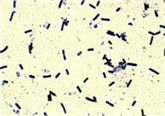Clostridium sordellii
General Information about C. sordellii
Clostridium sordellii [klaw–strĭ–dee–um sore–dell–ee–i] (also called C. sordellii) is a rare bacterium that causes pneumonia, endocarditis, arthritis, peritonitis, and myonecrosis. C. sordellii bacteremia and sepsis occur rarely. Most cases of sepsis from C. sordellii occur in patients with underlying conditions. Severe toxic shock syndrome among previously healthy persons has been described in a small number of C. sordellii cases, most often associated with gynecologic infections in women and infection of the umbilical stump in newborns.
Populations susceptible to C. sordellii infection
Women are at highest risk of infection from C. sordellii following the end of pregnancy, whether that pregnancy ended in a live birth, induced abortion (medical or surgical), or spontaneous abortion (miscarriage). Fatal infections with C. sordellii and C. perfringens have occurred after medical abortion. In some cases, women can carry the bacteria, but not be infected (known as colonization). The rate of vaginal colonization (when bacteria are present, but not causing an infection) with Clostridium species in the period after abortion has been reported to be as high as 29%, whereas these bacteria have been isolated in the vaginal secretions of 5%-10% of non-pregnant women. Researchers continue to study what percentage of women carries vaginal or rectal C. sordellii and C. perfringens before and after abortion, as well as during pregnancy.
Symptoms of C. sordellii infection
Symptoms of a C. sordellii infection include nausea, vomiting, diarrhea, and sometimes abdominal pain without fever. These symptoms often can occur in women after live birth or following a spontaneous, medical, or surgical abortion, so it is important to see a healthcare provider for further tests if someone is symptomatic.

For more images of this bacterium, search the Public Health Image Library
Transmission of C. sordellii infection
It is not known how C. sordellii is spread between persons or from the environment to persons. Other similar Clostridium species are spread from person to person and sometimes contaminated surfaces are involved in this transmission. Tests performed by the Food and Drug Administration (FDA) have not detected contamination with C. sordellii of either of the medications used in medical abortions. For more information see the Clostridium sordellii Toxic Shock Syndrome After Medical Abortion with Mifepristone and Intravaginal Misoprostol — United States and Canada, 2001–2005.
What CDC is doing
CDC experts in microbiology, epidemiology, and perinatology (pregnancy-related complications) are working together with state and local health agencies and the FDA in the investigation of recent deaths associated with C. sordellii. CDC is working with FDA to make the clinical and public health communities aware of research findings and to better identify the risks that may be associated with medical abortion. CDC will support FDA in identifying other potential cases, evaluating existing data sources, and continuing to monitor medical abortions in an effort to decrease infection risks associated with this procedure.
Additional Information
- Fischer M, Bhatnagar J, Guarner J, et al. Fatal toxic shock syndrome associated with clostridiumsordelliiafter medical abortion. N Engl J Med 2005;353:2352–60.
- Ho CS, Bhatnagar J, Cohen AL, et al. Undiagnosed cases of fatal clostridium-associated toxic shock in californian women of childbearing age. Am J Obstet Gynecol 2009;201:459.e1–7.
- Cohen AL, Bhatnagar J, Reagan S, et al. Toxic shock associated with clostridium sordellii and clostridium perfringens after medical and spontaneous abortion. Obstet Gynecol 2007;110:1027–33.
- Page last reviewed: November 24, 2010
- Page last updated: November 24, 2010
- Content source:


 ShareCompartir
ShareCompartir